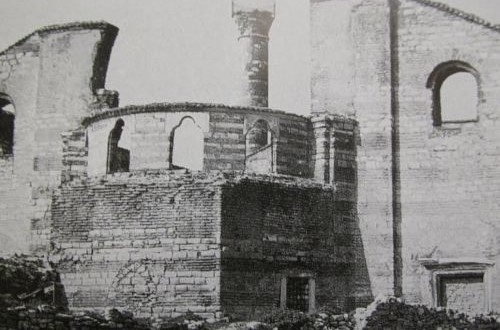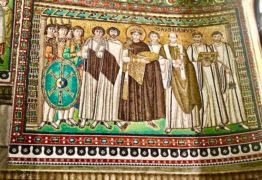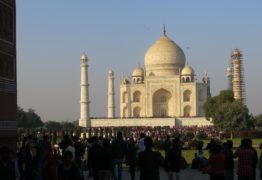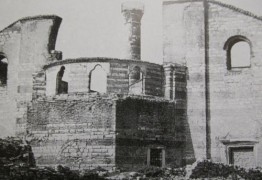Dear readers, A bunch of you have asked me where I am currently. I’m home in Minneapolis, Minnesota. Through this site I am blogging about the years I lived in Istanbul: 2010 through 2013.
“Greg, it’s been great talking to you, but I have to go,” I say into the telephone, glancing at my watch. It is just after 8 on a Sunday morning. Sankar and I often wake to a phone call from one of our adult children, for whom it is late night in Minnesota or New York. Today Greg is on the line, but he gets to talk only with me; Sankar is on a ten-day trip to South Africa and Dubai. And I’m in a hurry because I’m joining a tour of “Istanbul’s Seventh Hill” at 8:30 down on the Sea Road.
The conversation hasn’t been long enough for me to truly listen to Greg’s ideas and concerns, and I hang up feeling wistful. I could be more supportive if I wasn’t so far away.
Greg, 22, has been out of college for four months and he doesn’t have a job. He is sleeping on various friends’ couches in Manhattan, serving banquets and clerking in retail stores. We haven’t been overly concerned, feeling it is typical for a new graduate to flail a bit, particularly in the midst of The Great Recession. But when I think of him, struggling to gain traction in Manhattan, my heart goes out to him.
Greg and Angela visited us briefly in August and they got acquainted with Ümit. Now, as we drive around the city, he often asks if Greg has found a job yet. “No, nothing yet,” I always answer, and make a joke about couch surfing.
Finally one day, Ümit lets loose with a question it seems he has had for some time. It reveals how little he knows about the size of New York City and its distance from Minnesota—and what illustrious Americans he thinks Sandy and I are. “Don’t you and Sandy know anyone in New York?”
I’m pretty sure that my answer, an astonished, upwardly inflected “no,” is hard for Ümit to understand. A Turkish family would provide rent and a living allowance for unemployed offspring of any age.
Now, making sure I have my keys and camera, I leave the apartment building, closing the outer door carefully to avoid waking up ground-floor residents. Few Turks are out on the roads on Saturday and Sunday mornings, and I’m pretty sure my neighbors are also indulging in what seems to be a national preference for sleeping in.
Out of the compound, I turn right toward the edge of the hill that faces the Bosphorus and begin my descent. Past the mini-mart that sells homemade flatbread and where I’ve seen the male proprietors watching videotapes of Sex and The City. Thwack. My feet hit hard on the pavement that slants away from them, punctuating the negative thoughts I’m having. Why did Sankar bring me here to Turkey only to travel out of the country half the time? Thwack. Down the steep street lined with charming old houses. I have to introduce myself to a bus full of strangers today in order to have something to do. Thwack. Around the corner and onto the small road on which stray dogs occupy one side and cats occupy the other. I am far more alone here than I was back home. Thwack. Down the main street of Arnavutköy past the bakery, the kuruyemiş (dried fruits and nuts) shop, several kebab restaurants and a video store called The End. I can’t even help my kids because I’m too far away. Thwack.
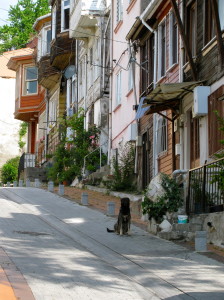
Today will be my first trip with the American Research Institute in Turkey, (ARIT), the group that I signed up with at the IWI fair in September. The Seventh Hill trip is billed as “a unique tour of the Byzantine and Ottoman city, and some of its important but little-visited churches and mosques.”
I’m down at sea level now, on flat ground. I turn right and see a bus sitting a few blocks ahead. A knot of people, perhaps a dozen, are standing outside of it. They look to be my age or older and are conversing animatedly. Thoroughly in a bad mood, I slow down and actually consider turning around and walking back up the hill. But what will I do all day alone in the apartment? I move toward the group.
A middle-aged Turkish woman with a dark pageboy sees me and introduces herself as Tulin, one of the trip organizers.
“Hi — welcome! What is your name?”
I tell her and she puts an X by it on her list. Then, smiling, I stand on the edge of the group, finally introducing myself to one couple. The woman’s name is Heleny. She is a retired school superintendent from Virginia, here in Istanbul teaching at the Üsküdar School for Girls. Üsküdar, formerly Scutari, is where Florence Nightingale established a hospital during the Crimean War. Heleny’s husband, Bill, is a retired lawyer. “I cook, but I don’t clean,” he quips.
It is time to board the bus, and I climb on. A dozen others are already seated. My instinct is to take one of four or five empty pairs of seats, but then I notice another lone woman and something makes me turn away from my solitude and put myself out. I ask if the seat next to her is free, and she nods.
I sit down and we begin to talk. She is fortyish and pretty, with light brown shoulder-length hair and large doe eyes. Her name is Elif. She is Turkish but tells me she has just returned to Istanbul after twenty years in London. The reason? A divorce from her British husband. She tells me it feels strange after two decades to be in Turkey, that London feels like her real home. Well, another outsider.
Elif and I converse as the bus starts up and this distracts me from my sour mood. I feel some of my negativity draining away. Our guide stands up in the front of the bus, picks up a microphone, and addresses us. He is Haluk Çetinkaya, a bald, 40-ish professor of archaeology from Istanbul’s Mimar Sinan University. He announces that, within a mere five block area on the Seventh Hill, we are going to see a 16th century mosque, a monastery complex that dates back to the 5th century, a Christian church from the 13th century, and a former soldier’s barracks that closed in the 1800s.
The bus rumbles south along the Bosphorus toward the Old City and then turns and winds away from the familiar tourist sites. We navigate narrow roads for ten minutes or so, stopping and starting, and then disembark in a part of town I haven’t seen before. Mostly filled with nondescript twentieth century buildings, it is apparently the Seventh Hill, and encompasses a western section of the ancient walled city.
We troop off the bus and gather together. I edge toward Professor Çetinkaya so street noise doesn’t prevent me from hearing what he says. He points across a wide, busy street at three freestanding walls arranged in a convex quarter circle. They are made of red brick and gray stone, giving them a striped appearance. Two of the walls have large arched window openings from which vegetation protrudes, and partial roofs that slant toward the wall in the middle, which is lower, with a convex bulge on top.
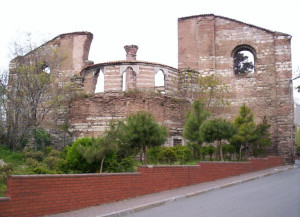
They are all that is left of St. John Studion, a religious complex that was founded in 462 CE by a Roman priest named Studius. It came into prominence as a monastery at the beginning of the 9th century, attracting Christianity’s premier calligraphers; composers of sacred hymns; and illuminators of manuscripts, some of which can be found in Venice and the Vatican City.
Functioning for a millennium up to and after the 1453 Muslim conquest, St John Studion inspired monasteries such as Mount Athos in Greece, but not long after the conquest, it became a mosque and the monks in residence were dismissed. Like human remains, this old church body is now merely a skeleton.
Mulling this tale of ephemerality, we are led down and across the street where Professor Çetinkaya points to a nineteenth century structure that looks like a hotel or apartment building. It is the former barracks of the Janissaries, the Ottoman Empire’s elite infantry troops. I have heard the word janissary before, but don’t know its significance.
The professor explains that the Janissaries were young boys recruited from Balkan Christian families starting in the 1500s and compelled (against the tenets of Islam), to convert. They received military as well as liberal arts training, and wore elaborate red and yellow uniforms and tall white tubular felt hats. Particularly talented recruits received a higher standard of education and became part of the Ottoman class of viziers (officials; the word is related to wizard) as well as engineers, architects, physicians, and scientists. Over its 300-year history, the Janissary system became hereditary and the Janissaries themselves gradually became corrupt and inclined to revolt. The system was abandoned in 1826.
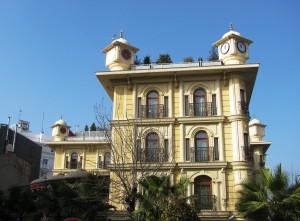
The most illustrious Janissary of all designed the next building we are to visit, the Şehzade (sheh ZA day) or Prince’s Mosque. As we walk toward this magnificent structure, we learn about Mimar Sinan (Sinan, the architect), for whom Professor Çetinkaya’s university is named.
Mimar Sinan is considered the greatest of all Ottoman architects, comparable to Michelangelo, his contemporary in the West. He was conscripted from a Christian family, probably of Armenian or Greek origin, in 1512, and worked for Turkish sultans throughout the 1500s, producing the loveliest mosques in Istanbul, along with schools, mausoleums, palaces, mansions, and bridges. Istanbul is adorned with Mimar Sinan’s work.
Mimar Sinan built the Şehzade Mosque in 1543 for Sultan Suleiman the Magnificent, who presided over the Ottoman empire at its apex. The purpose? To commemorate the death of Suleiman’s 22-year-old eldest son, Prince Mehmet, from smallpox. Suleiman was apparently so heartbroken that he sat with his son’s body for three days before allowing it to be taken away and buried. How his subjects must have pitied their ruler, his power and prestige granting no reprieve from death. Even sultans must bow to the will of Allah.
The Sehzade Mosque’s exterior glows in various shades of pink and white marble. The professor points out its elaborately-carved arches, its inlayed minarets, and its ribbed and fretted domes.
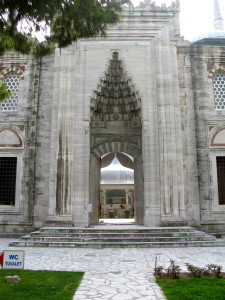
To enter, we pass through an elaborately carved stone entrance into a courtyard that contains a domed marble “ablutions fountain,” where male worshippers wash their hands and feet before praying. None of us do any washing, but we remove our shoes before walking up and into the carpeted mosque itself.
Inside, other people are milling around and several men are kneeling in prayer, but this is not one of the five daily prayer times during which non-Muslims are excluded. The professor invites us to sit down on the lush, deep orange carpeting while he begins explaining the building’s interior. My first impression is of sunshine and curved edges. Light seems to stream in from everywhere: the stained glass windows as well as the full and semi-domes above them.
The carpet features rows of dark blue repeating patterns about three feet by two feet in size, that look like arched doorways. These indicate where each worshipper is to kneel and the direction he is to face. In essence, these are the pews, and they run in rows all the way to the edge of the sanctuary, with no “aisles” or other spaces. This horizontal orientation makes the room appear wider than it is deep, and enforces a kind of equality among male worshippers (women occupy a confined space in the back of the mosque.)
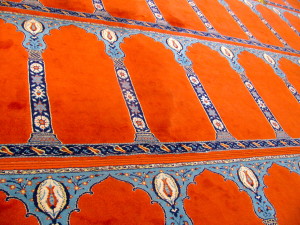
The central dome floats high above us, patterned in red, blue and black and bordered by burgundy and white stripes. Patterned half domes spring from the central dome, giving an impression of endlessness. This, I will learn, is a feature of all Sinan mosques.
Lowering our eyes, we see the mihrab, a stone niche indicating the direction of Mecca. Next to it is the mimbar, or pulpit, reached by a series of steps concealed by a curtain. The mimbar is capped by a fanciful turret painted in golds, blues and reds.
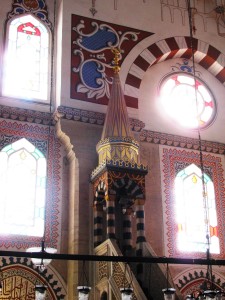
A black iron chandelier perhaps twenty feet in diameter hangs low in the middle of the sanctuary. Its swirl of curving lines and individual lights causes the mosque’s interior to sparkle. Arched colonnades extend around the building.
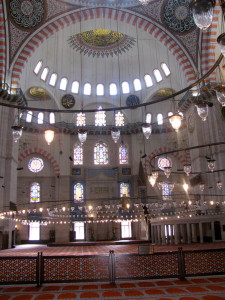
The Sehzade’s detailed, repeating patterns and inscriptions, and its layer-upon-layer surfaces give the building an air of eternal mystery that seems a perfect accompaniment to religious faith. Overall, my impression is of glory, not the severity I still expect in an Islamic structure.
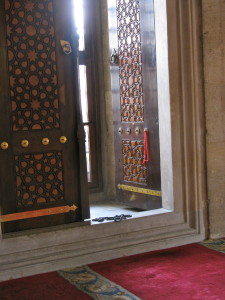
Professor Çetinkaya brings us out of our reverie by reminding us that the Şehzade Mosque was built only ninety years after the Muslim takeover of Constantinople. He then says something that surprises me, and he repeats it: “They were the same people. They were the same people.”
What does he mean? He explains that a new population was not brought in to replace the Christians living in defeated Constantinople. After the Conquest, the same people remained, gradually—or rapidly—switching their allegiance to the faith of their conquerors. So if one were to trace the ancestry of the people currently living on this land, Christian heritage would be uncovered. And farther back, one would find that these “same people” worshipped Greek gods and goddesses, maintaining statues of Zeus and Athena in their backyards.
This information makes me think differently of Turks, and I realize I’ve assumed religious beliefs are implacable. Later I will read that the Christian Byzantines felt that their defeat was a sign that God no longer favored their belief system.
Leaving the mosque, we walk on an unkempt path toward the Kalenderhane Mosque, a cozy sixth century former Christian church built on the site of Roman baths. One regime replacing another. The church’s orientation is north-south, but when the Ottomans replaced the Byzantines and it was converted into a mosque, its focus had to turn toward Mecca. Its carpeting, patterned to help worshippers face Mecca, is installed at a dizzying diagonal.
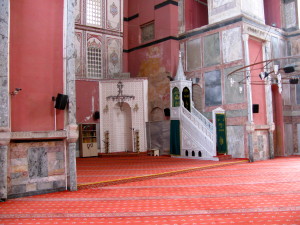
We stop at a kebab place for lunch and I meet some of my tour companions. Peter and Elaine, long-time Istanbul residents, he from the U.K. and she South African. A retired professor of history named Will, also British. Tulin, who helped organize the trip. A thin, older Japanese gentleman who sits reading a book written in Russian and doesn’t meet anyone’s gaze. Doug and Jean, here on a posting with the State Depatment. Friendly and unpretentious people, studious people, some delightfully eccentric. People a lot like me and, I remind myself, these folks were also new to Istanbul once, and disoriented. How easy it is to forget that.
As we sip tulip glasses of tea after lunch, people ask me about our arrival and jobs here, and encourage me to join upcoming ARIT tours, designed to go deep into the country’s history. It feels great.
In the afternoon, we are taken to a seven-turreted section of Istanbul’s ancient land walls called Yedikule (yedi = seven; kule = castle) and a functioning Greek Orthodox Church, for some reason also called the Balikli Camii, or Fishy Mosque, which has an underground spring full of goldfish. But at this point, I have hit a wall and am finding it difficult to receive, let alone integrate any more information. But I’m not complaining. The day has been dazzling, providing completely new insights, none of which are in my guidebook. It has taken me completely away from my everyday concerns.
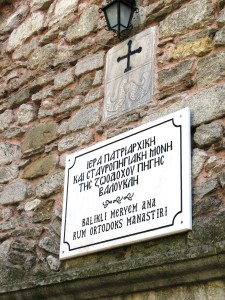
It is past 5 pm when we climb back on the bus. My legs ache and I am tired of listening. Funny how my empty apartment now seems like just the thing. But on the way back, the bus encounters heavy traffic on the narrow Sea Road, with no place to turn off. We sit only a mile and a half from our destination, but inching forward; we can do nothing but wait. This is Istanbul: narrow streets, lots of waterways, and serious traffic chokepoints.
Elif and I chat desultorily. Then a sixty-something woman in front of us turns around and introduces herself. Kate is attractive, with dark hair framing her face and large, dark eyes. She could pass as a Turk, but she tells us she is British, and she has an interesting story. Her parents worked for the British embassy and, growing up, she lived in several foreign countries, including the U.S. When she was in college in England, her parents were posted to Ankara, and on a visit to them one summer, she fell in love with a Turk. They married and have lived in Istanbul for forty years.
Kate tells Elif that for her, England feels strange, whereas Turkey is home. The two women’s stories are mirror images of each other. I ponder Elif’s current struggle and Kate’s long-ago adjustment to a Turkey much less modern than today.
The day has been filled with stories of dislocation and loss. A group of Byzantine scholars packing up for a long trip west, hoping perhaps Rome will take them in. The Janissaries, including Mimar Sinan, wrenched from their families and their religion. The magnificent Sultan, inconsolable over his young son’s death. A defeated city turning away from its faith. All of these dwarf my tiny current sufferings.
The entire city, it seems, is built on the concept of transplantation, the need to adapt and readapt to change. Perhaps all places are, but Istanbul seems more so, a crossroads for divergent peoples and the site of furious battles to establish religious supremacy. The day has given me a glimpse of the lessons this place might hold—as well as, surprisingly, my first, tiny sense of belonging.
The bus finally arrives, and I disembark, feeling weary but pleased. Spending the day around new people and beginning to learn about this complex city was just the tonic I needed. As I walk back up the hill, it occurs to me that perhaps as I learn to make my way here, Greg, displaced by choice, is also learning to navigate the polyglot port city he has chosen to live in.
And Sankar: well, now I have taken the lead: I can introduce him to some new people. Something drew me to that lonely ARIT table at the IWI fair in September, and it seems my instincts were sound. I know he’ll love the group’s focus on history and its welcoming members. I can’t wait to tell him about my day.
